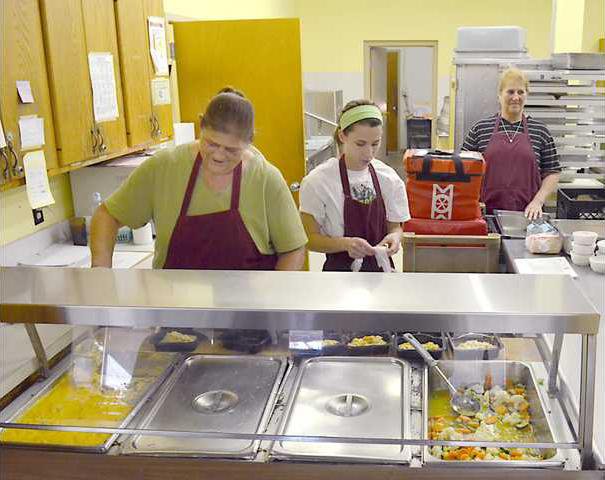Starting this month, lunch patrons of the Great Bend Senior Center and Meals on Wheels saw a change in the food they received, and some of the customers were not happy.
The meals, prepared at the center’s kitchen Mondays through Fridays, must now meet more stringent nutritional restrictions in an effort to make them more healthful, said Janet Splitter, executive director of Elder Care, the non-profit agency that oversees the food program.
“The whole goal is to keep people healthy,” said Splitter, who is also a registered dietician. “We want to reduce the chronic diseases that Americans are facing, diseases that are exacerbated in the older population.”
The food now has had the sodium, fat and carbohydrates reduced, Splitter said. “But, the meals look very similar to what they were before.”
Nonetheless, “there has been some concern,” she said. There have been complaints that some favorite menu items have vanished.
“We just ask that customers give us a cycle of menus using the new guidelines,” Splitter said. After the quarterly menu rotation is over, she suspects folks will find little has changed.
Senior Center Site Manager Rozy Tomlin said that prior to October, the facility served an average of 78 meals. However, in October, the numbers have been lower due in part she believes to the new food choices.
“At this age, they don’t like to be told what they can eat,” Tomlin said. But, she does understand the reasons for the revamped menu.
The same food served at the center is also distributed to participants in the Barton County Meals on Wheels program. This program serves about 55 to 60 meals daily in Ellinwood, Great Bend and Hoisington, or about 1,100 per month.
What is different?
In June, the Kansas Department of Aging and Disability Services published a new set of nutrition guidelines which went into effort Oct. 1. These were aligned with the United States Department of Agriculture’s and Health and Human Service’s 2010 nutritional guidelines.
“That’s what prompted the changes,” said Splitter, who was involved with the development of the state-level guidelines. The targets were heart disease, the nation’s deadliest health problem, and high blood pressure.
By 2020, the goal is to have no more than 500 milligrams of sodium in each meal. Presently, center meals range from 700 to 800.
“We’re making slow steps,” Splitter said. The kitchen staff has already been working for the past couple of years to make improvements.
In a nutshell, the menus involve the reduced sodium foods, whole and un-enriched grains, lower-fat dairy products, limited sugars and a wider variety of fresh fruits and vegetables. The same recipes will be used, but they will be tweaked a bit.
The two favorite meals, roast beef and oven-fried chicken, will not go away, she said. They will just be interspersed with other choices.
The guidelines call for beef, pork and fish to be served once per week, and chicken twice per week.
About the meal program
There are two programs under the Elder Care umbrella, Splitter said.
One is Home Services, which serves seniors in an eight-county region. This allows the participants to stay in their homes instead of being in a nursing facility.
The other is Friendship Meals. From the Older Americans Act, federal HHS money is channeled through the Southwest Kansas Area Agency on Aging, which covers 28 counties in southwest Kansas.
The SWKAAA contracts with Friendship Meals to serve 15 central kitchens, one of which is in Great Bend at the Senior Center. The local facility covers the Great Bend center, and satellite sites in Ellinwood, Hoisington and LaCrosse.
Splitter said Barton County Meals on Wheels is a separate non-profit that contracts with Friendship Meals to supply food. The MOW program is managed through the Retired Senior Volunteer Program office.
The center meals are available to those 60 or older and the full cost of each meal is $5.25. Those who qualify are eligible to get them for a suggested donation of $3.25, but according to the federal law, the customer doesn’t have to contribute.
To receive Meals on Wheels, someone has to qualify as home-bound, Splitter said. The pricing structure is the same.
“These are good meals,” she said. There are six items covering all the food groups.
“Some people are dependent on these,” she said. They may split the lunchtime meal into lunch and dinner.
“The meals enhance the variety of the food they get each day,” Splitter said.
There is also a social element. For some of the participants, their interactions at the center or with the person delivering their MOW food may be the only personal contact they have during the course of a day.
For the health of it
Changes make senior meals better for patrons, but there is grumbling





